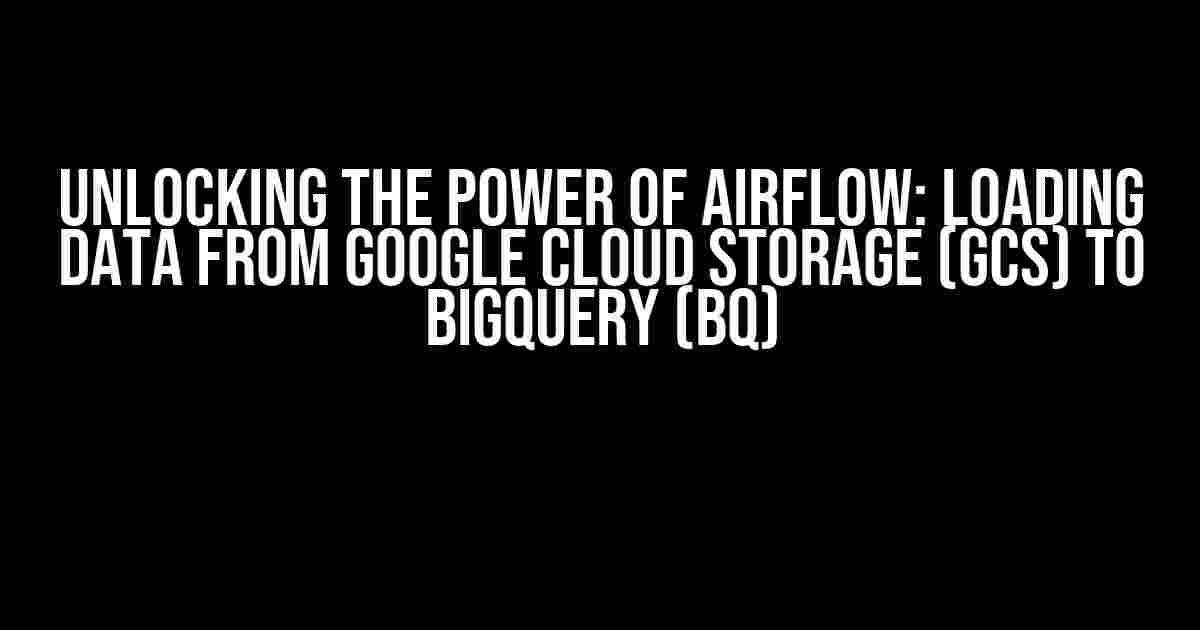Are you tired of tedious data loading processes holding you back from unlocking the true potential of your data? Look no further! In this article, we’ll explore the wonders of Apache Airflow, a powerful tool for automating data pipelines, and show you how to load data from Google Cloud Storage (GCS) to BigQuery (BQ) with ease.
What is Apache Airflow?
Apache Airflow is an open-source platform for programmatically defining, scheduling, and monitoring workflows. It’s a game-changer for data engineers, allowing them to create complex data pipelines with ease. With Airflow, you can automate tasks, schedule jobs, and monitor progress, all while ensuring data quality and integrity.
Why Choose Airflow for Data Loading?
- Flexibility**: Airflow supports a wide range of data sources and destinations, including GCS and BQ.
- Scalability**: Airflow can handle large datasets and scale to meet the needs of your organization.
- Reliability**: Airflow provides built-in retry mechanisms and task queuing, ensuring that your data loads complete successfully.
- Monitoring**: Airflow provides real-time monitoring and alerting, giving you complete visibility into your data pipelines.
Setting Up Airflow for GCS to BQ Data Loading
To get started, you’ll need to set up an Airflow environment and install the necessary dependencies. Follow these steps:
pip install apache-airflowairflow db initairflow webserverairflow scheduler
Next, you’ll need to install the necessary GCS and BQ operators:
pip install apache-airflow[google]
pip install apache-airflow[bigquery]
Creating an Airflow DAG for GCS to BQ Data Loading
A DAG (Directed Acyclic Graph) is a collection of tasks organized in a specific order. In this example, we’ll create a DAG to load data from GCS to BQ.
from datetime import datetime, timedelta
from airflow import DAG
from airflow.operators.dummy_operator import DummyOperator
from airflow.providers.google.cloud.operators.cloud_storage import CloudStorageDownloadOperator
from airflow.providers.google.cloud.operators.bigquery import BigQueryCreateExternalTableOperator
default_args = {
'owner': 'airflow',
'depends_on_past': False,
'start_date': datetime(2023, 3, 21),
'retries': 1,
'retry_delay': timedelta(minutes=5),
}
dag = DAG(
'gcs_to_bq',
default_args=default_args,
schedule_interval=timedelta(days=1),
)
download_file = CloudStorageDownloadOperator(
task_id='download_file',
bucket='your-gcs-bucket',
object='path/to/your/file.csv',
xcom_push=True,
dag=dag
)
create_table = BigQueryCreateExternalTableOperator(
task_id='create_table',
bucket='your-gcs-bucket',
source_objects=['path/to/your/file.csv'],
destination_project_dataset_table='your-bq-project:your-bq-dataset.your-bq-table',
schema_fields=[
{'name': 'column1', 'type': 'STRING'},
{'name': 'column2', 'type': 'INTEGER'},
# ...
],
dag=dag
)
end = DummyOperator(
task_id='end',
trigger_rule='all_done',
dag=dag
)
download_file >> create_table >> end
This DAG uses the `CloudStorageDownloadOperator` to download a CSV file from GCS and the `BigQueryCreateExternalTableOperator` to create an external table in BQ. The `DummyOperator` is used to mark the end of the DAG.
Running the DAG
Once you’ve created the DAG, you can trigger it manually or schedule it to run at a specific interval.
| Trigger Method | Instructions |
|---|---|
| Manual Trigger | Go to the Airflow web interface, navigate to the DAGs page, and click the “Trigger DAG” button next to the “gcs_to_bq” DAG. |
| Scheduled Trigger | Go to the Airflow web interface, navigate to the DAGs page, and toggle the “On” switch next to the “gcs_to_bq” DAG. The DAG will run according to the schedule interval specified in the DAG definition. |
Monitoring the DAG
Airflow provides real-time monitoring and alerting, allowing you to track the progress of your DAG. To monitor the DAG, follow these steps:
- Navigate to the Airflow web interface.
- Click on the “DAGs” tab and select the “gcs_to_bq” DAG.
- Click on the “Graph View” tab to view the DAG’s task dependencies.
- Click on a task to view its logs and details.
With Airflow, you can also set up email notifications and alerts for failed tasks, ensuring that you’re always informed about the status of your data pipelines.
Conclusion
That’s it! You’ve successfully loaded data from GCS to BQ using Apache Airflow. With this powerful tool, you can automate complex data pipelines, ensuring that your data is always up-to-date and ready for analysis.
Remember, Airflow is a highly customizable platform, and this article has only scratched the surface of its capabilities. Experiment with different operators, sensors, and workflows to unlock the full potential of Airflow and take your data engineering skills to the next level!
Happy automating!
Frequently Asked Questions
Get the scoop on loading data from Google Cloud Storage (GCS) to BigQuery (BQ) with Airflow!
What is the best way to load data from GCS to BQ using Airflow?
You can use the `google.cloud.storage` and `airflow.providers.google.cloud.operators.bigquery` modules in Airflow to load data from GCS to BQ. Simply create a DAG that reads data from GCS using the `GCSSensor` and then loads it into BQ using the `BigQueryOperator`.
How do I authenticate Airflow to access my GCS and BQ resources?
You need to set up authentication using the `google-auth` library and provide the necessary credentials, such as a service account key or OAuth credentials, to authenticate Airflow to access your GCS and BQ resources.
Can I load data from GCS to BQ in real-time using Airflow?
Yes, you can! Airflow provides a `GCSSensor` that can monitor your GCS bucket for new files and trigger a DAG to load the data into BQ in real-time. This way, you can keep your BQ datasets up-to-date with the latest data from GCS.
How do I handle errors and retries when loading data from GCS to BQ using Airflow?
Airflow provides a built-in `retry` mechanism that allows you to specify the number of retries and the retry delay in case of errors. You can also use `try-except` blocks to catch specific exceptions and handle them accordingly. Additionally, you can use Airflow’s `Logging` module to log errors and monitor the progress of your DAGs.
Can I use Airflow to load data from GCS to BQ for a specific time range or incremental loads?
Yes, you can! Airflow provides a `GCSSensor` that allows you to specify a time range or incremental loads based on file timestamps or other criteria. This way, you can load only the new or updated data from GCS to BQ, which can be useful for incremental data loads or data backups.

